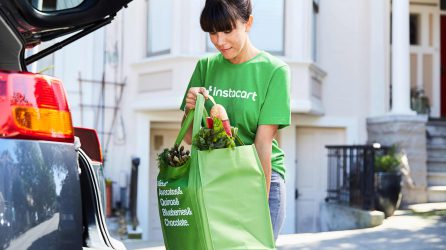Online grocery optimization 101: What CPGs need to know about retail SEO

Presented by:
Stephanie Rubin — 2022
At a time when more shoppers are buying their groceries online and experimenting with different online grocers, CPGs face an urgent question: How do you make sure your products are visible on retailer sites, so you can get them into online baskets?
Being smart about on-site retail search is a big part of the answer.
A huge percentage of add-to-baskets on eGrocery sites come from the top five search results. On Instacart, 70% of conversion from search happens in the first row, and 62% comes from the first four items. In other cases, it can be as much as 90%.
What’s more, there’s a flywheel effect. Once a shopper buys you online, many retailers make it easy to repurchase using ‘buy it again’ widgets. Over time, past purchases can account for as much as a third of items in online baskets.
In other words, winning in search once can set you up to win over and over again. That’s why CPGs that are serious about online grocery optimization need to be serious about search optimization.
So, what are the key things to know when it comes to winning in grocery SEO?
Be clear about what’s expected and what’s allowed
Your search performance on retailer sites stands and falls with how well you understand your retailer’s search architecture and strategy, and where you fit in.
Whether you’re focused on winning in organic search or investing in paid / sponsored search, remember you’re operating on the retailer’s turf. Grocery retailers put limitations on what CPGs are allowed to do on their sites, so you’ll have less control over optimization than you might be used to elsewhere. Certain tactics and strategies may simply not be possible.
That’s why it’s critically important for CPGs to invest time to really understand the retailer’s strategic point of view, what drives their algorithm, and their expectations for brand owners.
Every retailer has their own rules for engagement, so ‘one size fits all’ won’t work. Some give you 500 words of product description; others give you 100. Some allow search terms related to competitor brands; others don’t. Some allow cross-category search terms; others want the relevance to be in the category. Don’t assume that because one retailer allows you to do certain things or associate certain terms with your product, they all will.
CPGs should also have a clear idea of where products are going to appear in search results. Most grocery retailers have a hero page, a category page, an aisle page, and various sub-pages. It’s important to understand how search results are going to populate on any given page, and where products are going to show up. This will help you construct the keyword tagging, so your products come to the top of the page when customers are searching.

Don’t rely on conventional SEO wisdom
Throughout, keep in mind that conventional SEO wisdom has limited application within retail search. Hyper-targeted or obscure search terms are unlikely to produce the right results. That’s where I’ve seen some SEO authorities make mistakes – they’re so focused on the outliers, the abstract terms, that they end up missing 80% of shoppers.
To place well on retailer sites, CPGs need to use search terms that resonate with the majority of shoppers. Using the shopper insights your team has developed, along with sources like Google Adwords, will help you come up with the best strategy for your portfolio.
Staying on top of shopper data and search trends is especially important in the current climate of ever changing consumer needs. Certain consumer behavior has changed as a result of the tectonic shifts brought forth by the pandemic. Shoppers are showing increased interest in healthy and wellness, for example.
Adjusting key word tagging in line with these trends can help improve your search performance, so CPGs should put real effort into data mining what their customers are searching for on the internet over the coming months.
Keep a keen eye on paid search ROI
As well as optimizing for organic search, CPGs should also pay close attention to the evolution of paid search on retailer sites.
Several retailers now operate their own media groups and networks as they try to monetize search and search management in new ways. As a result, some prominent search positions are no longer attainable for CPGs unless they pay.
Much of this is driven by the profitability gap in online grocery. Because eCommerce is less profitable for retailers than brick-and-mortar, they are exploring new ‘pay to play’ options to help close the gap between what they can charge for home delivery and curbside pickup versus what it costs them.
None of this is unusual – retailers are always looking for ways to monetize things – but CPGs need to understand the implications for their own search strategies.
As more retailers push paid search, it’s critical to keep a really slick eye on budgets and return on investment. Be clear on what you’re trying to achieve with your search spend, and be careful you’re not pushed into something that doesn’t deliver results.
Having a strong sense of priorities is important more generally. Many CPGs have a tendency to spread their search efforts too thin or waste money on off-strategy search terms. Remember it’s those top five search spots that are critical. Instead of spreading your time, money, and energy, identify your highest-priority items and back those with meaningful action and spend.
Don’t set it and forget it
Whether you’re focusing on paid or organic search, it’s critical you don’t make the mistake of ‘setting and forgetting’. You need to continually monitor how your products appear on retailer sites and check what’s been published is accurate.
I can’t emphasize this enough: You have to ensure the data submitted is accurate and accurately published. You can’t assume that because you’ve done it right once means you don’t have to look at it ever again.
As online grocery sales are said to make up 11.2% of total US grocery sales by 2023, there’s a real opportunity to get a greater share of wallet through online grocery optimization and being smart about what you do with search. But if you get complacent and take your eye off the ball, no retail SEO strategy in the world will get you good results.
Ready to scale your retail SEO success?
We help global brands win on the digital shelf worldwide with the analytics and strategic approach outlined in this article. Book a free demo to see how we can help you scale your digital shelf success.
All the digital Shelf Analytics You Need to Succeed at Speed & Scale
See why world leading brands choose e.fundamentals for actionable digital shelf insights
Request A demoLatest Resources

CommerceIQ Launches Global Retail Ecommerce Management Platform Combining Sales, Supply Chain, Retail Media, and Digital Shelf with e.fundamentals Acquisition
Ecommerce platform enables consumer brands to grow market share profitably in today’s inflationary and supply-constrained environment through intelligent automation, supporting over 450 omnichannel retailers in 41 countries.

e.fundamentals becomes a CommerceIQ company
e.fundamentals has been acquired by CommerceIQ, the leading Retail Ecommerce Management Platform, headquartered in Palo Alto, California. Consumer brands can now harness one global software platform to power profitable market share growth across all major retailers.

5 strategic pricing opportunities CPGs should focus on now
As tensions run high between retailers and suppliers, CPGs need to be smarter than ever about strategic pricing. Here’s how to use digital shelf analytics to hold your own in tough negotiations.

What the smartest CPGs get right about selling on Instacart
This post has been updated and was originally published March 30, 2021. It's time CPGs get ready to win on Instacart. So read and learn: What's all the hype around…

5 optimization tactics to grow digital shelf sales
This post has been updated and was originally published May 14, 2020. Consumer goods companies (CPG) continue to grapple with enormous shifts to the industry as the eCommerce boom continues…

5 tactics to grow online sales for category managers
Category management has changed. We've highlighted the 5 tactics to help you scale your growth on the digital shelf at speed.
View Our Most Popular resources to help you learn and win on the digital shelf.

The Ultimate Guide to Content Management on the Digital Shelf

The Digital Shelf Cast - Listen to our latest episode





